Influence of the Internal Structure Type of a Large-Area Lower Exhaust Workbench on Its Surface Air Distribution
Abstract
:1. Introduction
2. Subjects and Methods
2.1. Geometric Models
2.1.1. Models of the Workbench for Structural Research
2.1.2. Model of the Workbench for Experimental Validation
- (1)
- Although the method shown in Figure 2b was the same for both, the bottom plate was inclined in the experimental workbench, while it was horizontal in the numerical simulation workbench with Structure-4.
- (2)
- Although both workbenches were set with five internal slits, the widths of the slits in the experimental workbench were 0.04 m, 0.045 m, 0.05 m, 0.07 m and 0.095 m from left to right, while they were all 0.06 m in the numerical simulation workbench with Structure-4.
- (3)
- To eliminate the influence of the orifice plate on the airflow distribution, the multi-hole orifice plate was not set in the surface of the numerical simulation workbench with Structure-4, while it was set in the surface of the experimental workbench. The diameter of the holes in the multi-hole orifice plate was 2 mm, the spacing between the holes was 2 mm, and the arrangement of the holes was 60° staggered.
2.2. Research Conditions
2.3. The Grid Sensitivity Tests
2.4. Experimental Workbench and Test Methods
3. Results
3.1. Velocity Contours for Differently Structured Workbenches
3.2. Workbench Surface Velocity for Differently Structured Workbenches
3.3. Velocity Vector Maps for Differently Structured Workbenches
3.4. Experimental Validation Results
4. Discussion
5. Conclusions
Author Contributions
Funding
Institutional Review Board Statement
Informed Consent Statement
Data Availability Statement
Conflicts of Interest
References
- Huang, Y.; Wang, Y.; Liu, L.; Nielsen, P.V.; Jensen, R.L.; Yan, F. Reduced-scale experimental investigation on ventilation performance of a local exhaust hood in an industrial plant. Build. Environ. 2015, 85, 94–103. [Google Scholar] [CrossRef]
- Lunden, M.M.; Delp, W.W.; Singer, B.C. Capture efficiency of cooking-related fine and ultrafine particles by residential exhaust hoods. Build. Environ. 2015, 25, 45–58. [Google Scholar] [CrossRef] [PubMed]
- Chen, J. Research on the axial velocity change rule of desktop slot exhaust hood. Ind. Health 2018, 56, 278–284. [Google Scholar] [CrossRef] [PubMed]
- Chen, J.; Sun, Y.; Zhang, X.; Chen, Z.; Yang, B.; Liu, W. Study on the upper flange width on grinding worktable and its ergonomics evaluation. In Proceedings of the Man–Machine–Environment System Engineering, MMESE 2019, Lecture Notes in Electrical Engineering. Shanghai, China, 19–21 October 2019; Long, S., Dhillon, B.S., Eds.; Springer: Singapore, 2020; Volume 576, pp. 827–835. [Google Scholar] [CrossRef]
- Liu, L.; Dai, J.; Yang, J.; Jin, M.; Jiang, W.; Lu, X. Intelligent simulation experimental study on influence of velocity of air supply hood and exhaust hood with vertical push pull ventilation. J. Intell. Fuzzy Syst. 2019, 37, 4819–4826. [Google Scholar] [CrossRef]
- Li, Y.; Huang, X.; Yu, I.T.; Wong, T.W.; Qian, H. Role of air distribution in SARS transmission during the largest nosocomial outbreak in Hong Kong. Indoor Air 2005, 15, 83–95. [Google Scholar] [CrossRef] [PubMed]
- Melikov, A.K. Advanced air distribution: Improving health and comfort while reducing energy use. Indoor Air 2016, 26, 112–124. [Google Scholar] [CrossRef] [PubMed]
- Wang, Y.; Quan, M.; Zhou, Y. Effect of velocity non-uniformity of supply air on the mixing characteristics of push pull ventilation systems. Energy 2019, 187, 115962. [Google Scholar] [CrossRef]
- Wang, J. Pressure drop and flow distribution in parallel-channel configurations of fuel cells: U-type arrangement. Int. J. Hydrog. Energy 2008, 33, 6339–6350. [Google Scholar] [CrossRef]
- Chen, Z.; Wang, H.; Zhuo, J.; You, C. Experimental and numerical study on effects of deflectors on flow field distribution and desulfurization efficiency in spray towers. Fuel Processing Technol. 2017, 162, 1–12. [Google Scholar] [CrossRef]
- Şahin, B.; Ward-Smith, A.J.; Lane, D. The pressure drop and flow characteristics of wide-angle screened diffusers of large area ratio. J. Wind Eng. Ind. Aerodyn. 1995, 58, 33–50. [Google Scholar] [CrossRef]
- Chen, J.; Yang, B.; Liang, S.; Chen, Z.; Sun, Y.; Zhang, T. Study on the Performances of Supply Air for Uniform Air Supply Square Hood by Numerical Simulation. In Proceedings of the Man–Machine–Environment System Engineering, MMESE 2017, Lecture Notes in Electrical Engineering. Jian, China, 22–23 October 2017; Long, S., Dhillon, B.S., Eds.; Springer: Singapore, 2018; Volume 456, pp. 449–455. [Google Scholar] [CrossRef]
- Chen, J.; Jin, L.; Chen, Z.; Yang, B.; Zhou, S. Center-Line Velocity Change Regime in a Parallel-Flow Square Exhaust Hood. Int. J. Environ. Res. Public Health 2020, 17, 4485. [Google Scholar] [CrossRef] [PubMed]
- Chen, J. Changing Patterns of the Flow Ratio with the Distance of Exhaust and Supply Hood in a Parallel Square Push-Pull Ventilation. Int. J. Environ. Res. Public Health 2022, 19, 2957. [Google Scholar] [CrossRef] [PubMed]
- Ye, W. Design method and modeling verification for the uniform airflow distribution in the duct ventilation. Appl. Therm. Eng. 2017, 110, 573–583. [Google Scholar] [CrossRef]
- Liu, J. Exploring the effect of air duct structure optimisation on the uniformity of airflow organization in metro car interiors. Technol. Wind 2021, 4, 117–118. [Google Scholar] [CrossRef]
- Su, W.; Wu, F.; Zhang, G.; Xu, R.; Li, X.; Zhong, S. Structural optimization of the tapered air ducts of a subway train. J. Railw. Sci. Eng. 2021, 18, 2137–2144. [Google Scholar] [CrossRef]
- Chen, J.; Bai, Y.; Yang, B.; Liu, L.; Liu, W. Research on the Uniform Air Supply Technology of the Static Pressure Chamber in a Spray Room. In Proceedings of the Man–Machine–Environment System Engineering, MMESE 2020, Lecture Notes in Electrical Engineering. Zhengzhou, China, 24–26 October 2020; Long, S., Dhillon, B.S., Eds.; Springer: Singapore, 2020; Volume 645, pp. 589–596. [Google Scholar] [CrossRef]
- Wu, X.; Liu, L.; Luo, X.; Chen, J.; Dai, J. Study on Flow Field Characteristics of the 90 Rectangular Elbow in the Exhaust Hood of a Uniform Push–Pull Ventilation Device. Int. J. Environ. Res. Public Health 2018, 15, 2884. [Google Scholar] [CrossRef] [PubMed] [Green Version]
- Sun, Y.; Shen, H. Industrial Ventilation, 4th ed.; China Construction Industry Press: Beijing, China, 2010; pp. 41–42. [Google Scholar]

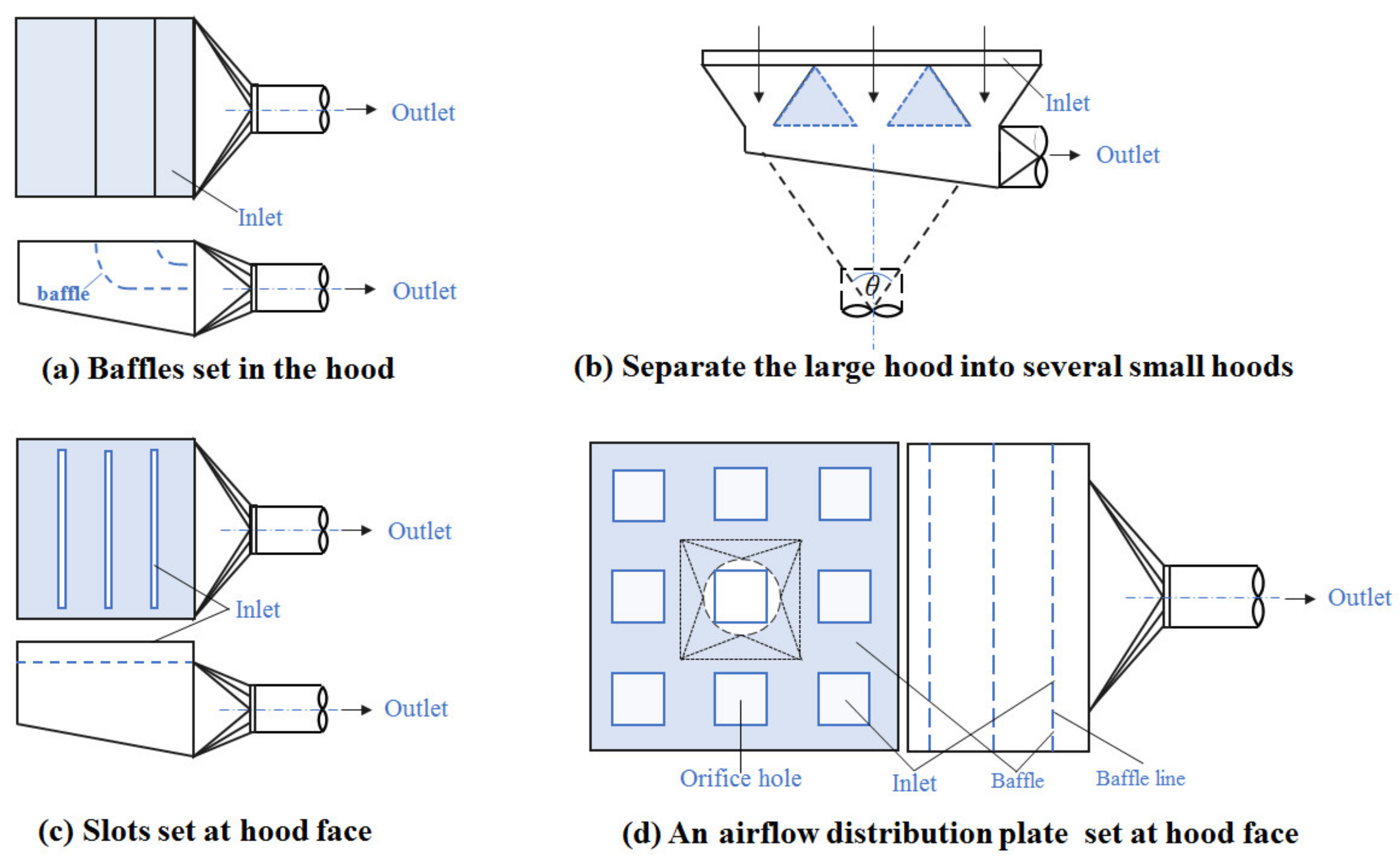
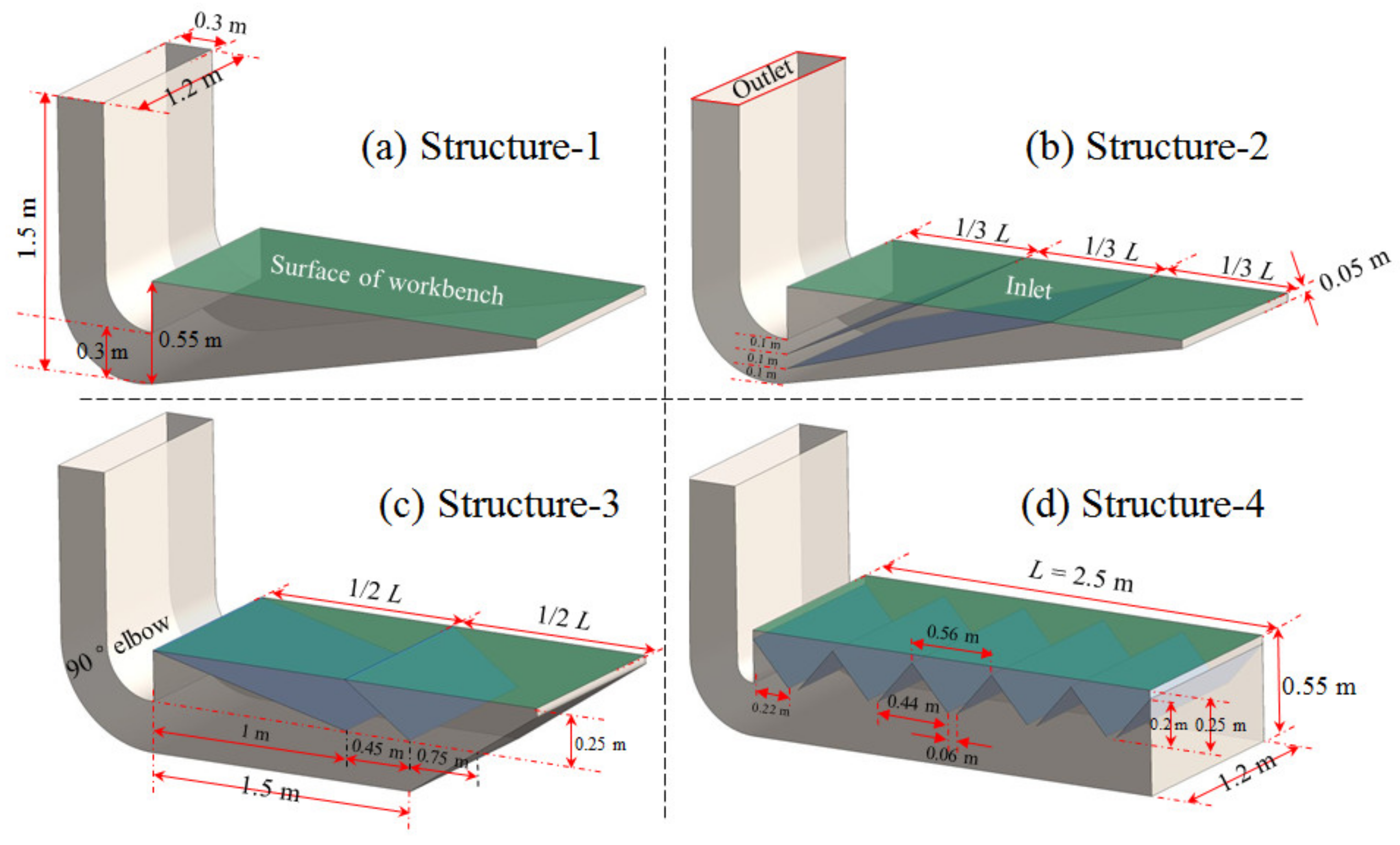
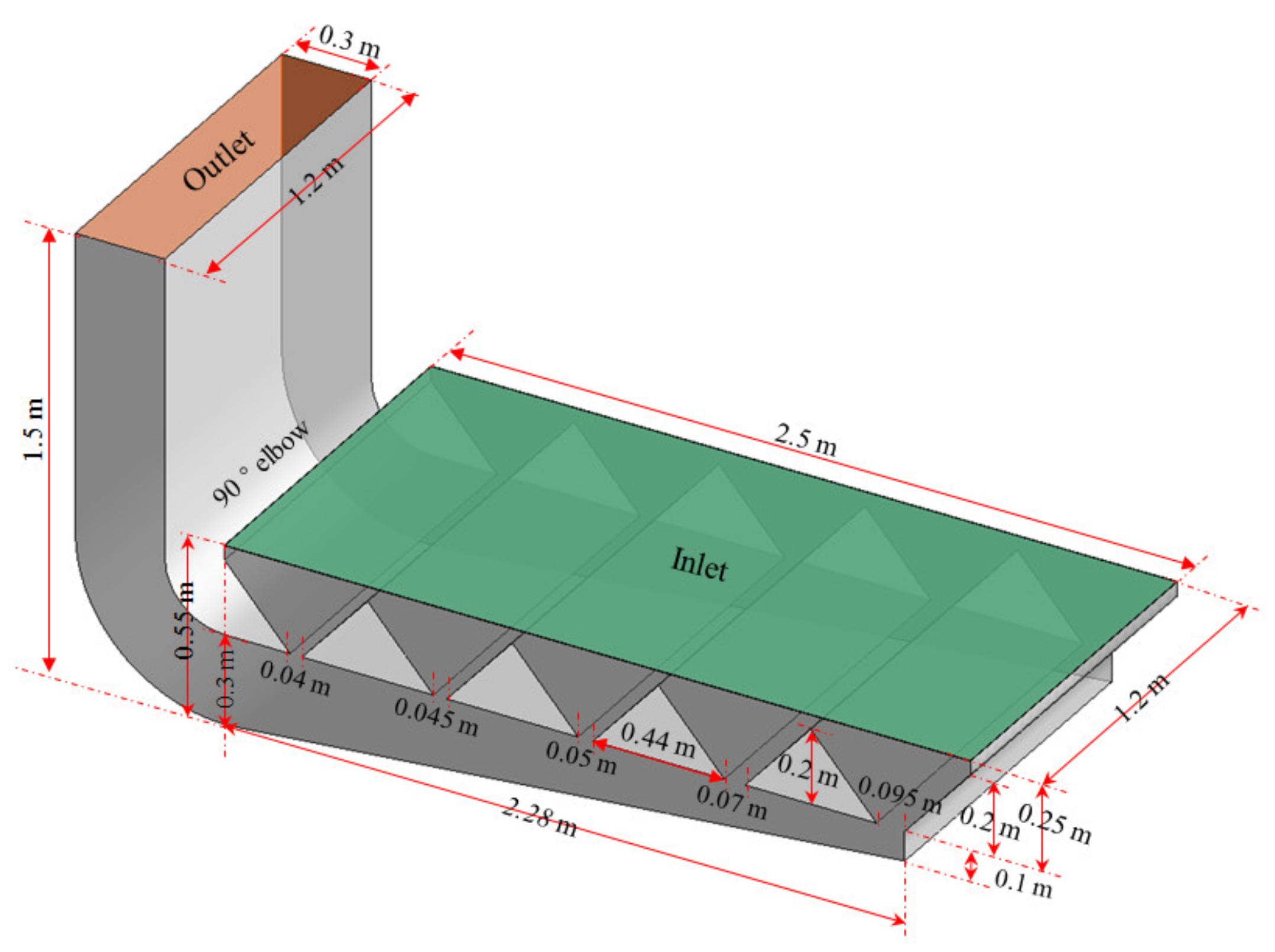

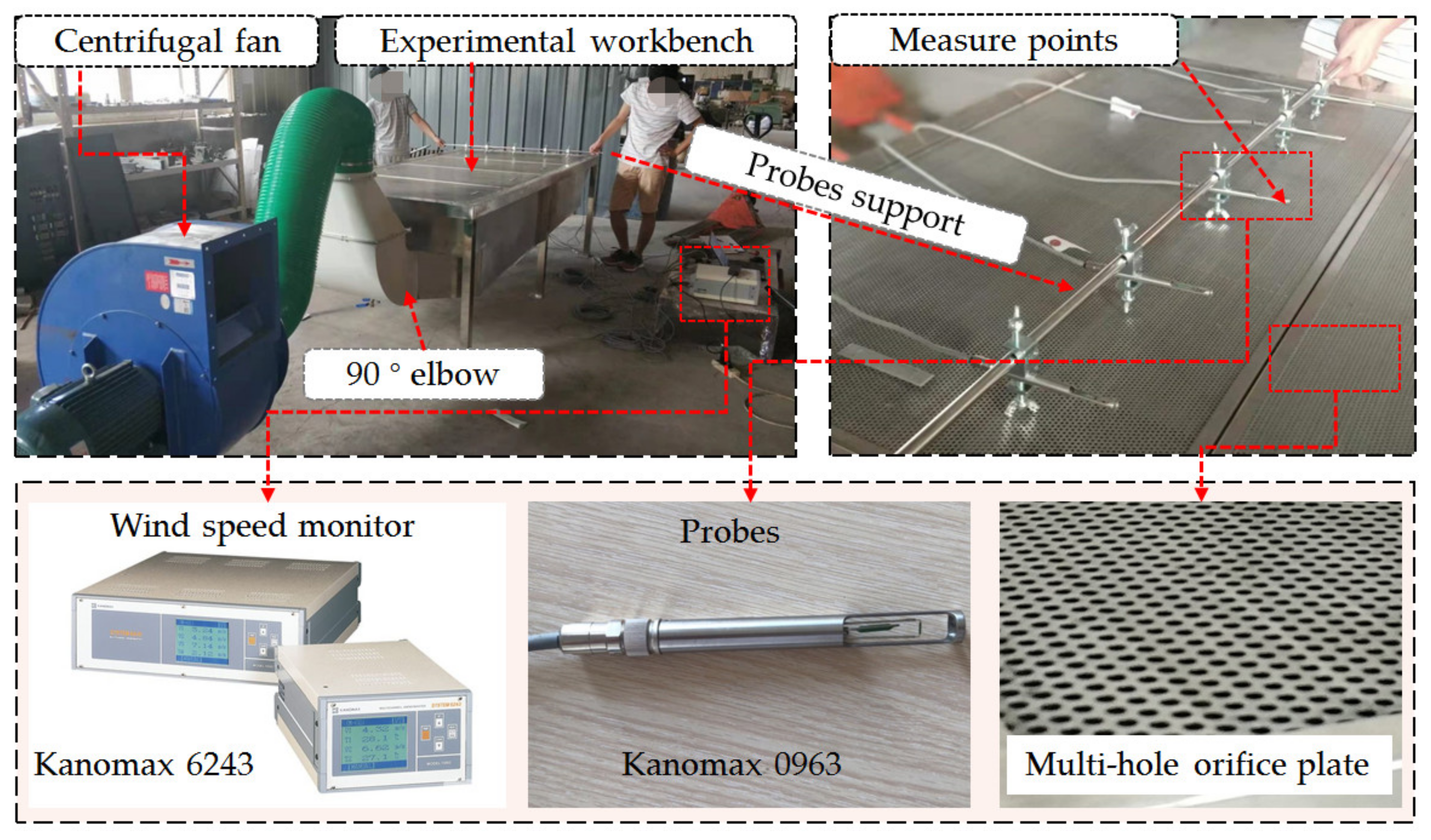
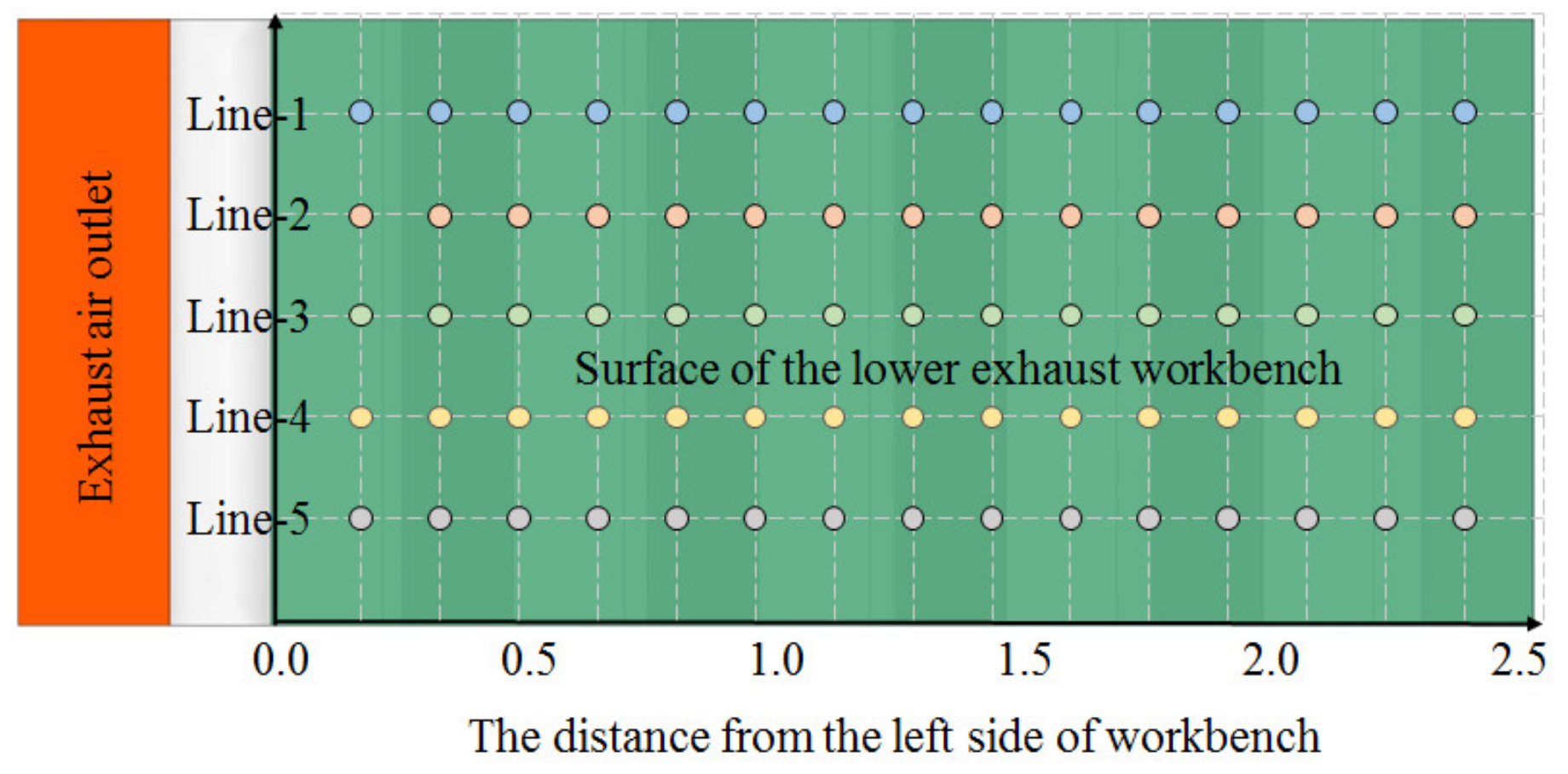
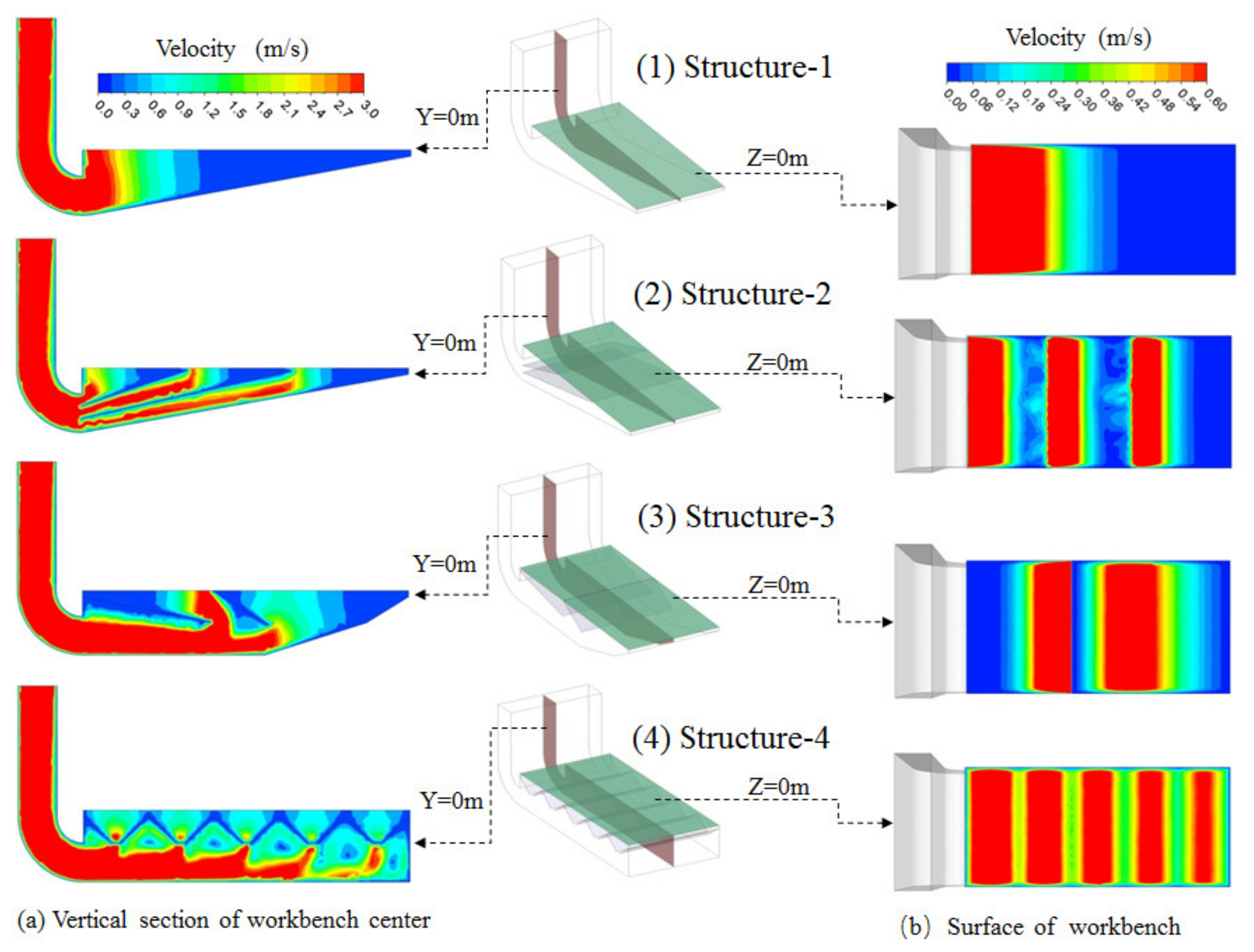

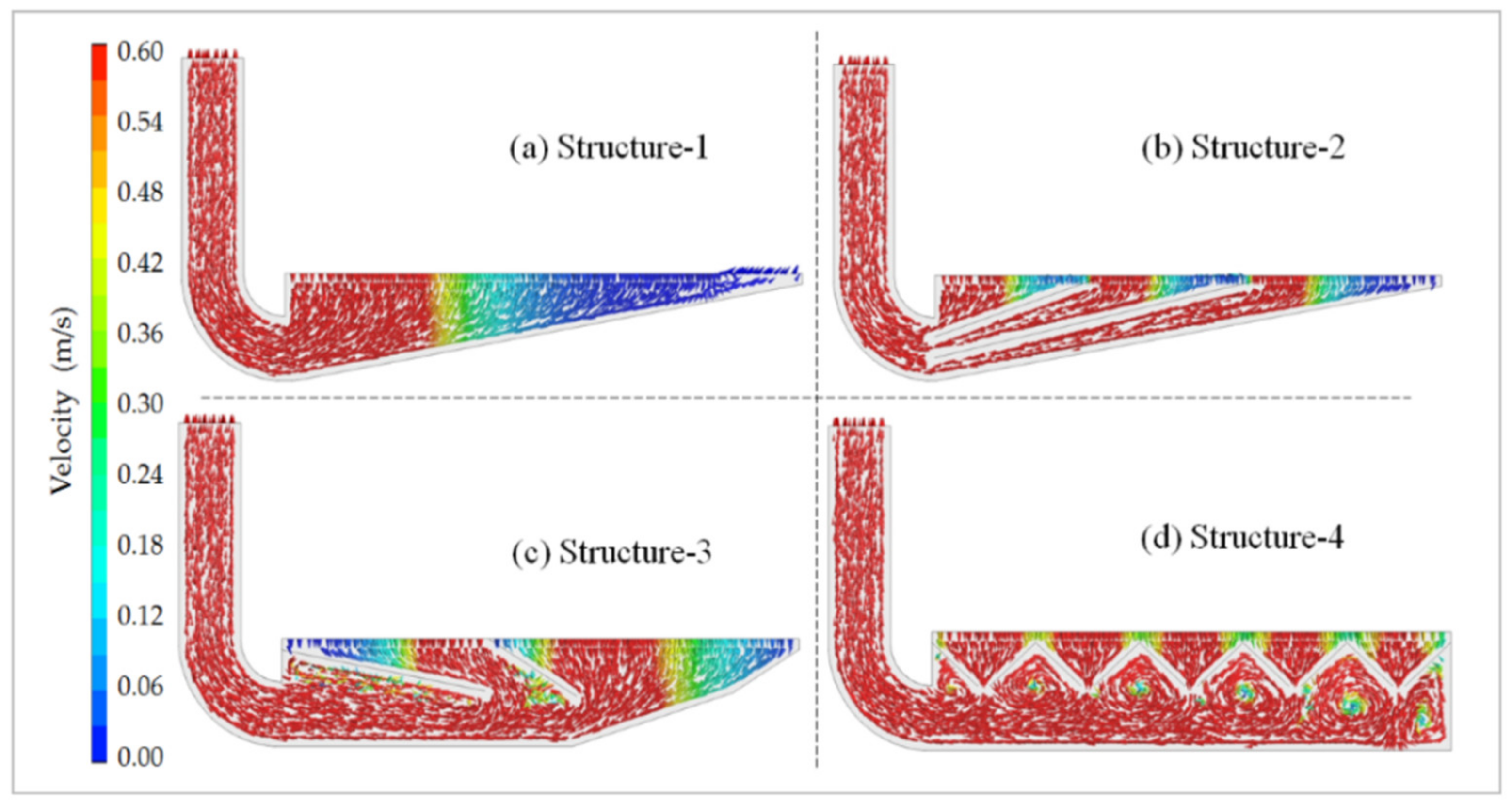

| Solver Parameters | Parameter Settings |
|---|---|
| Solver type | Pressure-based |
| Solver velocity formulation | Absolute |
| Solver time | Steady |
| Viscous model | Standard k-epsilon |
| Species transport | Off |
| Energy | Off |
| Pressure–velocity coupling | SIMPLEC |
| Spatial discretization | Second order upwind |
| Convergence criterion | 10−6 |
| Interaction to plot and store | 1000 |
| Wall condition | Stationary wall/No slip |
| Boundary Conditions | Parameter Settings |
|---|---|
| Outlet | Surface of lower exhaust workbench |
| Outlet boundary type | Pressure outlet |
| Gauge pressure (Pa) | 0 |
| Inlet | Air outlet of elbow |
| Inlet boundary type | Velocity inlet |
| Velocity at inlet (m/s) | –5 |
| Material | Air |
| Air viscosity (kg/m/s) | 1.81 × 10−5 |
| Hydraulic diameter of inlet (m) | 0.48 |
| Turbulence intensity of inlet (%) | 3.81 |
Publisher’s Note: MDPI stays neutral with regard to jurisdictional claims in published maps and institutional affiliations. |
© 2022 by the authors. Licensee MDPI, Basel, Switzerland. This article is an open access article distributed under the terms and conditions of the Creative Commons Attribution (CC BY) license (https://creativecommons.org/licenses/by/4.0/).
Share and Cite
Chen, J.; Jin, L.; Yang, B.; Chen, Z.; Zhang, G. Influence of the Internal Structure Type of a Large-Area Lower Exhaust Workbench on Its Surface Air Distribution. Int. J. Environ. Res. Public Health 2022, 19, 11395. https://doi.org/10.3390/ijerph191811395
Chen J, Jin L, Yang B, Chen Z, Zhang G. Influence of the Internal Structure Type of a Large-Area Lower Exhaust Workbench on Its Surface Air Distribution. International Journal of Environmental Research and Public Health. 2022; 19(18):11395. https://doi.org/10.3390/ijerph191811395
Chicago/Turabian StyleChen, Jianwu, Longzhe Jin, Bin Yang, Zhenfang Chen, and Guoliang Zhang. 2022. "Influence of the Internal Structure Type of a Large-Area Lower Exhaust Workbench on Its Surface Air Distribution" International Journal of Environmental Research and Public Health 19, no. 18: 11395. https://doi.org/10.3390/ijerph191811395






